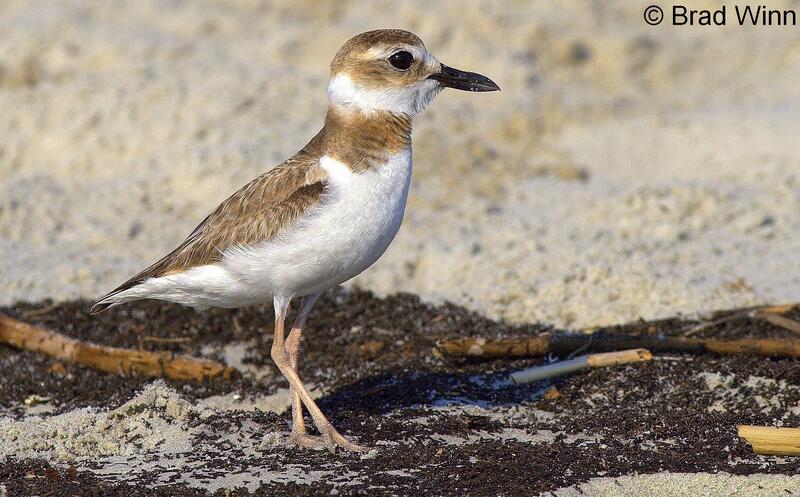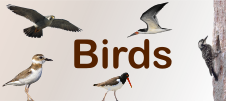







Loading profile. Please wait . . .
Anarhynchus wilsonia (Ord, 1814)
Wilson's Plover




Federal Protection: No US federal protection
State Protection: Threatened
Global Rank: G5
State Rank: S2
Element Locations Tracked in Biotics: Yes
SWAP 2015 Species of Greatest Conservation Need (SGCN): Yes
SWAP 2025 Species of Greatest Conservation Need (SGCN): Yes
2025 SGCN Priority Tier: High Conservation Concern
Element Occurrences (EOs) in Georgia: 20
Habitat Summary for element in Georgia: Sandy beaches; tidal flats
The Wilson's plover is about 20 cm (8 in) in length. Its crown, cheek, back, and upper wings are brown. The white on the forehead tapers into a line that extends over the top of the eye. The throat, breast, abdomen, and underside of the wings are white, with a white collar extending to the back of the neck. During the breeding season, the male has a broad black collar-like band on the lower throat; this band is brown on the female and the non-breeding adult male. The breeding male also has a black patch on the top of the forehead. The bill of both sexes is black and is large for a medium-sized plover. Legs are pinkish to fleshy-gray in color. Juveniles look very similar to adult females.
The semipalmated plover (Charadrius semipalmatus) is similar in appearance but is slightly smaller with yellowish legs and a much smaller bill that often has some yellow color near the base. The snowy plover (C. alexandrinus) and the piping plover (C. melodus) are also similar in appearance but both have light sand colored backs, upper wings, and heads and much smaller bills. The snowy plover has gray legs while the piping plover has yellowish or yellow-orange legs. The killdeer (Charadrius vociferus) also looks similar to the Wilson's plover but is a much larger bird (26-27 cm) with two wide black bands on its neck and upper chest and a red-orange rump and upper tail; however, it is rarely found in the same habitats as the Wilson's plover.
Coastal beach habitats including dry sand beaches, dunes, newly forming beaches, intertidal sand flats, mudflats, saltpans, and coastal lagoons. Breeding habitat in Georgia is primarily on the outer barrier island beaches, with limited nesting on dredge deposit sites.
Crustaceans, especially fiddler crabs, shrimp, insects, and spiders.
This plover arrives at breeding sites along the Georgia coast in late March or early April and begins nesting by late April. Nesting territories are established on depositional areas of beach including sand terrace flats and dune overwash fans as well as sparsely vegetated dunes and embryonic dune fields. The male scrapes out a depression in the sand near a clump of grass, small shrub, or similar vegetation. This scrape is usually downwind from this vegetation, which acts as a windbreak. Normally 2-3 eggs are laid and incubated by both parents for 23-27 days before hatching. The female performs most daytime incubation, while the majority of night-time incubation is done by the male. Young leave the nest with the adults soon after hatching and forage on the wet beach of the outgoing tide. They are thought to become independent in about 21 days, although this has not been confirmed. While most nesting takes place in May, active nests can be found from late April through late June. A few individuals can be found wintering in Georgia most years.
Pedestrian searches of suitable beach nesting habitat from April through June is the best tool to monitor breeding populations. While nests can be very difficult to find, nesting pairs or adults with dependent young are often visible. Mid-winter shorebird surveys will document the presence of this species during the winter; however, few individuals use the Georgia coast at this time of year.
Wilson's plovers are found breeding on the Atlantic Coast from Virginia to Florida, much of the Gulf Coast from Florida to the Yucatan Peninsula of Mexico, on several islands of the West Indies, locally along the Pacific Coast of Mexico from the Gulf of California south to Nayarit, and at a few sites on the Pacific Coast of Central America. Most birds winter along the Atlantic and Gulf Coasts from Florida to Brazil and along the Pacific Coast from the Gulf of California to Peru. Small numbers can be found regularly wintering on Egg Island Bar, Little St. Simons Island, and Cumberland Island.
Loss of nesting habitat to beachfront development; destruction of nests and young by humans and vehicles; disturbance by humans and pets; and predation by wild, feral, and domesticated animals are the greatest threats to this species. Wilson's plovers are particularly vulnerable to disturbance by humans and pets and several of the sand spits and small barrier islands they use for nesting are used heavily as picnic and rest areas by recreational boaters. Heavy foot traffic in the vicinity of nests may lead to abandonment by the adults. Pets, particularly dogs, may kill adults and young or destroy the eggs.
| Threat 1 | Threat 2 | Threat 3 | |
|---|---|---|---|
| General Threat | Human intrusions & disturbance | Invasive & other problematic species, genes & diseases | Climate change & severe weather |
| Specific Threat | Recreational activities | Problematic native species/diseases | Habitat shifting & alteration |
The state’s nesting population is approximately 100 pairs. Nesting occurs on some sand spits islands and on all major barrier islands except Tybee and St. Simons; however, larger numbers of nesting pairs are only found on Little St. Simons and Cumberland Islands. A few nesting pairs also occur on dredge spoil islands at Kings Bay Naval Submarine Base in Camden County and at Andrews Island in Glynn County.
Protection of breeding habitat, reduction of disturbance by humans, and reduction of predation are needed to ensure this species' survival. In some locations, closure of beaches to public access during the breeding season may be warranted. Trapping of raccoons and other beach predators also may be needed in the future. Systematic surveys of the breeding population should be conducted every 3–5 years to monitor and assess population trends. The small wintering population along Georgia's coast is monitored by the annual mid-winter shorebird survey. During the last five years (2006-2010) of this survey an average of 45 Wilson's plovers per year were found wintering here.
Bent, A. C., ed. 1929. Life histories of North American shorebirds, Part 2. U.S. National Museum Bulletin 146.
Bergstrom, P. W. 1988. Breeding biology of Wilson's plovers. Wilson Bulletin. 100:25-35.
Burleigh, T. D. 1958. Georgia Birds. University of Oklahoma Press, Norman. 746pp.
Corbat, C. A. 1990. Nesting ecology of selected beach-nesting birds in Georgia. Ph.D. Diss., University of Georgia, Athens. 174pp.
Hayman, P., J. Marchant, and T. Prater. 1986. Shorebirds: an identification guide. Houghton Mifflin, Boston. 412pp.
Rappole, J. H. 1981. Management possibilities for beach-nesting shorebirds in Georgia. Pages 114-126 in R. R. Odom and J. W. Guthrie, eds. Proceedings of the Nongame and Endangered Wildlife Symposium. Georgia Department of Natural Resources Technical Bulletin WL 5.
Schneider, T. M. 1999. Wilson's Plover (Charadrius wilsonia). Pp. 38–39 in T. W. Johnson, J. C. Ozier, J. L. Bohannon, J. B. Jensen, and C. Skelton, eds., Protected Animals of Georgia. Georgia Department of Natural Resources, Wildlife Resources Division, Nongame Wildlife–Natural Heritage Section, Social Circle.
Tomkins, I. R. 1944. Wilson's plover in its summer home. Auk 61:259-269.
Winn, B. 2010. Wilson's Plover (Charadrius wilsonia). Pp. 160-161 in T. M. Schneider, G. Beaton, T. S. Keyes, and N. A. Klaus, eds. The Breeding Bird Atlas of Georgia. University of Georgia Press, Athens.
Todd M. Schneider and Bradford Winn
T. Schneider, 1999: original account
B. Winn, 2010: Breeding Bird Atlas species account
T. Schneider, July 2010: modified and edited text
K. Owers, July 2010: updated status and ranks, added pictures